What Lies Beneath: URI Surveys Rhode Island Waters
Note: SaNfaP is on Facebook! Go to facebook.com/scienceandnatureforapie and click on “Follow” to receive pictures, facts, and more about the natural world. Then suggest that your friends do the same. They’ll thank you. -HM
It takes Captain Tom Puckett a moment to decide on the most unusual fish he’s brought aboard the URI research vessel Cap’n Bert. Tall, lanky, and sporting curly gray hair, Puckett has been responsible for piloting the vessel most of the past 25 years. He chews Dentyne gum as he ponders the question. “I’d have to say the Atlantic torpedo ray. They can generate enough electricity to knock you out. Haven’t seen too many of them, though.” Today will be an example of the cliché, “never say never.”
The R/V Cap’n Bert is a 53-foot stern trawler owned by URI, and has been used for the School of Oceanography’s fish trawl survey since 1987. The state funded surveys are weekly trips to the waters off Wickford and those near Whale Rock, at the mouth of the West Passage in Narragansett Bay. On each outing, a team of graduate and undergraduate students record the names, numbers, and sizes of fish caught using a net dragged along the bottom. It’s a process that has been going on since 1957 and, according to their web site, “the fish trawl survey is the longest continuous record of fish and invertebrate relative abundance in Rhode Island.”
On this morning’s trip, the autumn air is a brisk 32°, but the wheelhouse is warm. Inside are Puckett, URI grad student and current fish trawl assistant Sarah Blackstock, and URI undergrad Allee Bruce, also an assistant. At nine, the boat slowly pulls out of its slip and sails toward its first destination near Fox Island. Though the air is cold, there is almost no wind, an unusual autumn weather condition for which all aboard are thankful. Survey trips are conducted in all but dangerous weather, every week, year ‘round, so this is a good weather day.
In a short time, the boat reaches the location of the first pass. Being consistent is a vital element in any scientific survey, and the path the trawl will take is the same each week. Before lowering the nets, Blackstock assesses water quality. Taken at two different depths, the instruments she uses will monitor things such as the amount of oxygen dissolved in the water, levels that are essential for keeping fish and invertebrates healthy. Other measurements will determine water temperatures and salinity. Like the results of the fish surveys, information collected in water quality testing is an important record of changes in the marine environment over long periods of time. 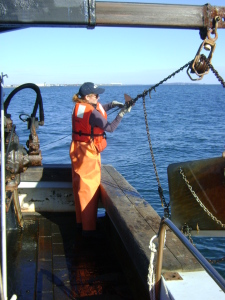
Once the boat stops, Blackstock, clad in orange foul weather gear and life vest, steps to the stern of the boat to ready the net and facilitate its descent. The water here is between 20 and 26 feet (approximately 6 – 8 meters), and the bottom is composed of soft mud and shells. Captain Puckett begins to lower the nets through the use of a winch operated from the wheelhouse. Once the net is in the water, steel rectangular plates called otter boards are launched. The two- by four-foot otter boards are used to keep the net on the bottom and the opening of the net as wide as possible. As it travels, the top of the net will float roughly three feet above the bottom. The forward movement of the net will cause the bottom fish to stir, with some going straight up, others directly into the rear of the oncoming net. Like the water quality tests, the fish and invertebrates collected will contribute to a database that monitors long and short term changes in the complex web of organisms that comprises the marine environment.
As the net reaches the bottom, the boat begins to move forward at a leisurely pace. The determination has been that two knots, a bit slower than the average human walks, is the appropriate speed to gather the quarry. The net will open to 40 feet wide as it is dragged over one nautical mile. According to Puckett, the damage done to the bottom in this process is minimal. “There’s not as much damage as you might think. Most of this area is a dense, sandy, clay bottom. Fishermen who are spending tens of thousands of dollars on their nets aren’t about to have them dragging over rocks and getting torn to pieces.”
The distance is covered and the net begins to be pulled. The winch cranks up the steel cables that bring the heavy load to the surface. Collected specimens gather at the end until, once it rises from the water, it looks like a five-foot-in-diameter brown beach ball. At first, it looks like the net is bulging with mud. But as Blackstock releases the rope at the base of the net, it becomes apparent that the coloration culprit is very much alive.
These are sea squirts. Thousands and thousands of them. So many that undergrad assistant Allee Bruce begins the sorting process with a large shovel to dig through them. Sea squirts are part of the tunicate family, and with leathery exteriors that resemble…well, tunics. They are filter feeders, which means they take water (and microorganisms) into their bodies, siphon off the food, and expel the water again.
Although the presence of filter feeders is normally counted as a good thing, it seems the sea squirts have nearly taken over this region. The sense on board is that there isn’t enough evidence to determine whether or not this many tunicates may be harmful. Still, there would be a doctoral dissertation in trying to answer that question, no doubt.
Gradually, the great piles of sea squirts are removed and dumped back into the water. The other species are counted and divided into what amount to heavy-duty orange laundry baskets. While awaiting weighing and measuring, the basketed fish are immersed in blue plastic barrels of sea water to insure they still have sufficient oxygen to endure the wait. Most will be returned to the water unharmed; a few will be unable to handle the stress of the whole process and will not survive. As unfortunate as this may sound, the consensus is that the knowledge gained by conducting these surveys far offsets the mortality rate. In fact, one of the reasons the survey was created was to enable scientists to gain a thorough, first-hand account of changes in migratory fish populations. In earlier days, scientists were left to rely on reports from fishermen, which produced far more guesswork.
The haul is recorded, and it’s on to deeper water. The crew retreat to the wheelhouse for a seat and a snack, and to warm up a bit after splashing around with the fishes. “I think the puffer fishes are my favorites,” Sarah Blackstock says, referring to the odd little fish that inflate their bodies with water when in distress to appear larger and less appetizing. Captain Tom Puckett reflects on the trends in fish catch: “It used to be that we’d get odd fish – sting rays, torpedo rays, flying fish – only after a hurricane. Now we’re seeing those warm water species more frequently,” likely due to climate change.
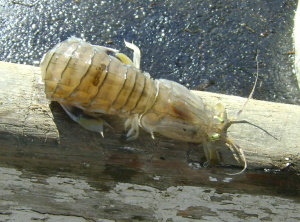
The mantis shrimp features one of the fastest attacks of any animal, along with a pair of preying mantis-like claws that, in some areas, give it the nick-name “thumb splitter” for the nasty jab it can produce when handled.
The next trawl will be in the 60 – 80’ waters off Whale Rock, and the crew leaves the wheelhouse to prepare to lower the nets. After the rest and warmth, Allee Bruce pumps her arms back and forth to fight the renewed chill that touches all on the deck. If the shallow water drag was dominated by the overwhelming presence of the sea squirt, this run will make up for that lack of variety. Including one fish with the ability to severely injure anyone who handles it too carelessly.
This time when the massive ball of fish is lowered to the deck, there is a large animal inside with what seems to be a pink body. Blackstock quickly goes to the wheelhouse and brings Puckett to verify her suspicions about its identity. Before the load of fish is lowered, Puckett confirms that today is a day where one of the more unusual catches will pay a visit: the Atlantic torpedo ray.
This is a much larger ray than the ones often seen washed up on local beaches. The torpedo ray in the net is roughly five feet long and four feet across, roundish in shape with an odd pink belly and mud-brown back. The dramatic nickname comes from its ability to generate a painful and powerful electric shock from two organs on the top of the ray. At 170 – 220 volts, handling this must be done with care. Because of this, the ray must be removed from the sorting area first.
With the threat of an electrical blast to protect it, this ray has no need for the stinger at the end of its tail that is common to other species. Instead, it has a paddle-shaped tail (the caudal fin). This would seem to be a convenient location for grabbing it and placing into one of the holding basket. The trouble is, the torpedo ray is also exceptionally slimy, making getting a grip on the writhing, 70-pound creature difficult. Puckett hauls it onto the deck, but lifting it into a basket while avoiding the shock pads is more challenging. Finally, he receives help and the ray is deposited, if awkwardly, into the basket. Because of both the potential danger and the relative rarity of the find, the ray is the first to be measured, then dumped back in the ocean to return to the muddy bottom it calls home.
The rest of the catch brings a mixture of surprises and the usual suspects: scup, skates, shad, sea robins, along with dollar fish (named for their resemblance to silver dollars), red hake with “whiskers” (called chin barbels) half the length of its body, and a conger eel. The latter is over three feet long (96 cm.), with a substantial girth. Despite their appearance, local congers are harmless. Still, there’s something disconcerting in seeing the eel raise its head out of the water of the capture barrel and try to escape.
It takes over an hour to count, measure, and weigh the deep water catch. As the Cap’n Bert returns to dock, there is a last chore to do, and all pitch in to scrub down the deck, the baskets, the barrels, and finally the now-slimy foul weather gear the crew wears. The data recorded from today’s trip will be added to records that date back half a century. In other week, the research vessel will return to the ocean and maintain its steady watch on the creatures of the deep.




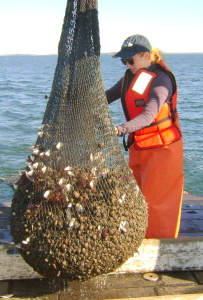


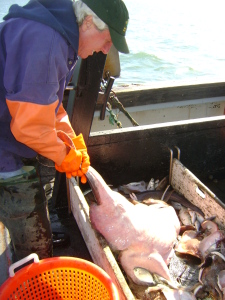
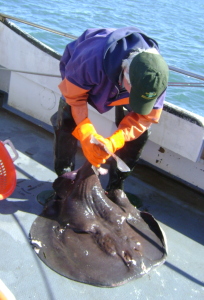

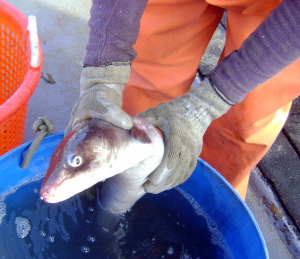
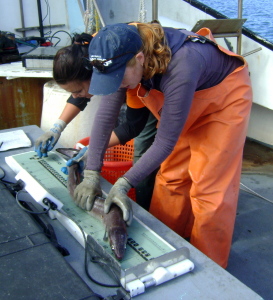
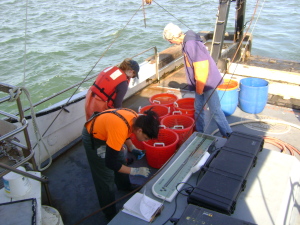






Congratulations Hugh, I applaud your understanding of the subject matter and your ability to convey it in a clear and interesting manner. And of course your help on deck. The fish populations are thinning down like our summer residents do and soon it will just be us out there until the seasons change back again. Come visit and stay in touch. Best, Tom.
Glad you liked the story, Tom. I had a great time out there; I’d gladly trade places with you! Even in rough weather! If you’re on Facebook, there’s a page devoted to the blog, and you can keep up with the latest. I’ll still be using photos of the many oddball fish we saw as mini-posts. http://www.facebook.com/scienceandnatureforapie is the address, or check back here every week or two to read the latest blog posts. Great working with you! – H